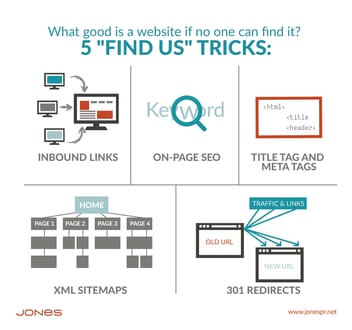Where's Your Site? Five Keys to Website Search Success

Hide-and-seek. Word searches. Where’s Waldo? Metal detectors. Rummage sale treasure hunters. Some people love the hunt for the hidden and obscure when it’s a fun way to while away the time.
But when your potential customers are looking for a solution to problem, searching high and low and looking into nooks and crannies for what they have missed is the last thing they want to do. They want to find the answer quickly and easily.
How easily can they find you?
If you aren’t at the top of the search results pages, you aren’t being found. Studies show that 60 percent of all “clicks” go to the first three organic (not paid) results. (Click to tweet!) In fact, a full 75 percent of searches never even look beyond the first page of results. (Click to tweet!)
So how do you land those coveted top spots? Here are five keys to website search success to focus on.
Inbound links
When I’m traveling to a new town and looking for a good place to eat, I usually ask friends who already live in that area for their recommendations. If lots of them recommend the same place, it goes to the top of my “must-try” list.
Search engines use a similar tactic when choosing what websites get top billing in search results: if lots of other sites link to them, they get a higher priority. Search engines refer to it as authority. The more inbound links you have, the more important your site must be and the higher you will rank.
So how do you get other sites to link to yours?
Our two top tips:
1. Create high-quality educational or entertaining content. If people like your content, they will naturally want to link to it and share it with others.
2. Write guest posts for other blogs, or feature guest writers on your own blog. This is a win-win for both parties, as you link to each other’s pages and increase readership for both blogs by exposing new readers to what you have to share.
XML sitemaps
The idea behind an XML sitemap is to help search engine crawlers, sometimes called spiders, sort through the pages on your site more efficiently to identify what each page contains.
The sitemap is an .xml file with a list of all your pages and when they were updated; like a flow-chart or family tree, it also shows the structure of your website and where your pages reside. Sitemaps can be created using online generators that will create the .xml file for you, which is then uploaded to the root directory of your website.
Be sure to update the sitemap regularly as your website changes and grows. As more content is added to the site, it needs to be added to the map as well.
301 redirects
You’ve seen that screen that is the online equivalent of a dead end: 404 Page Not Found. Somehow it always seems to be the most promising link that comes up short of what you had hoped to find.
Don’t leave potential visitors at a dead end when they are trying to find your site. Once you’ve gotten those coveted inbound links (see above), don’t risk losing them when you choose to move a page on your website. Instead, use a permanent 301 Redirect to send those links (and search engines indexing pages) to the new location.
Title tag and microdata
Title tags and microdata may not directly impact your actual search engine rankings, but they do have the potential to increase click-through rates on search results by 30 percent. (Click to tweet!) Why would you want to miss out on that?
Both are created in the backend of your website, written into the HTML to tell search engines how your site should appear in their results. The title tag indicates the title of the page seen at the top of a web browser, as well as the main headline displayed in search engine results. How often have you been on a page whose title was “Home Page” with no indication of what the website actually is? Why would you not take two minutes to make that title say “Jones” or “HubSpot” or “ABC Widgets”?
Microdata are slightly more involved, but can make the difference between a result listing that looks like a garbled mess and one that clearly spells out information about your business such as hours, location, or contact information. It involves more coding and using a standardized vocabulary such as Schema.org, which seems like the territory of web developers. However, marketing needs to be involved, too, to make sure the right message gets through. Here’s a cheat sheet to help marketers speak HTML.
On-page search engine optimization
Did you think I was going to forget this one? Keywords! Keywords! Keywords! Sometimes it seems like that is the only thing some people think of when they want to boost their search rankings. I didn’t put it last because it isn’t important; I put it last so you wouldn’t ignore those other tactics we already discussed.
On-page SEO and keyword density are a delicate balance between writing for people (because they are the ones actually reading your content and making decisions) and optimizing for the search engines that bring people to your page. So write your content for people first, then go back to tweak it for search.
Do keep your keywords in mind, though, when writing the copy, choosing a primary keyword for each page. Focus on optimizing that page for that word (or long-tail keyword). If you try to use too many keywords, the page will lose its importance and authority because search engines won’t have a clear idea of what the page is about.
Once you have your primary keyword, be sure to include it in:
-
Headlines
-
Subheads
-
Body content (as long as the use is relevant)
-
File names for images or the ALT tag
-
Page URL
If that seems like a lot to keep track of, try using our on-page SEO template to organize each page.
I know you understand how important all of this is if you want potential customers to find your website, but here’s one more statistic to underscore it a bit more: More than 90 percent of all B2B purchases start with online research. (Click to tweet!) That’s no kids’ game.
-1.png?width=1652&height=294&name=Jones(RGB)-1.png)












